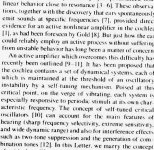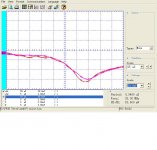Off topic, and Happy New Year
Yes. I was invited to two different parties, both of which promised good wine and food. I decided to accept the one at the home of a wine collector who might well have produced some rather old and interesting things. But yesterday he called to say that his wife was in a state (she's given to these, historically) and just couldn't do it.
Rather than trying to get back in the other party, I decided this was an indication that I should stay in tonight
Happy New Year and a safe night to all.
Yes. I was invited to two different parties, both of which promised good wine and food. I decided to accept the one at the home of a wine collector who might well have produced some rather old and interesting things. But yesterday he called to say that his wife was in a state (she's given to these, historically) and just couldn't do it.
Rather than trying to get back in the other party, I decided this was an indication that I should stay in tonight
@ Waly & kgrlee,
Waly, yes i am aware of the later discussion and the additional information given at the BAS site.
I´d say that your question illustrates one of my concerns; the most natural answer to your question would be "just look in the article" , but it simply contains no such information.
And it contains no measurement of the overall frequency response of the combined listening equipment as well.
See for comparison the linked (some posts ago) publications by Oohashi et al. and Nichigushi et al. .
In the Meyer/Moran report i could not find any information about the number of listeners involved nor the number of trials for each listener.
They mentioned some scores of 8/10 and 7/10 which occured once and two times, but that does not meet the total number of trials nor that of the subgroups (for example the female listeners scored 18 out of 48 trials)
While post hoc analysis is dangerous (wrt familywise error rates), the results of the subgroups call for further examination (for example the female listeners- two tailed analysis, p=0.056 for <=18 hits out of 48 trials by chance) .
The number of 19 records was given, but we don´t know which of these were used in an unknown number of listening trials.
After three months it was noticed that the high-res player was defective up to a certain degree in one channel (wrt to low level linearity), but we don´t know how many trials have been done with this unit, nor if it was defective from the beginning.
At least the reference material no. 4 (Blech and Yang) found that 4 of their listeners could detect a difference between DSD and PCM material so it is not quite right to state that their research confirms the results of Meyer/Moran.
It does not help, if one of the experimenters expresses his opinion about the only correct test result that has to occur.
I have some concerns about the method to examine the transparency of the additional circuitry; if it were sufficient to know what listeners "felt" about the audibility of something we surely woudl not need to do any controlled listening experiments at all .
And last but not least, the experimenters did not use positive controls.
Waly, yes i am aware of the later discussion and the additional information given at the BAS site.
<snip>
Anyone have comments on their list of SACDs .. especially on the presence or absence of supersonics?
I´d say that your question illustrates one of my concerns; the most natural answer to your question would be "just look in the article" , but it simply contains no such information.
And it contains no measurement of the overall frequency response of the combined listening equipment as well.
See for comparison the linked (some posts ago) publications by Oohashi et al. and Nichigushi et al. .
In the Meyer/Moran report i could not find any information about the number of listeners involved nor the number of trials for each listener.
They mentioned some scores of 8/10 and 7/10 which occured once and two times, but that does not meet the total number of trials nor that of the subgroups (for example the female listeners scored 18 out of 48 trials)
While post hoc analysis is dangerous (wrt familywise error rates), the results of the subgroups call for further examination (for example the female listeners- two tailed analysis, p=0.056 for <=18 hits out of 48 trials by chance) .
The number of 19 records was given, but we don´t know which of these were used in an unknown number of listening trials.
After three months it was noticed that the high-res player was defective up to a certain degree in one channel (wrt to low level linearity), but we don´t know how many trials have been done with this unit, nor if it was defective from the beginning.
At least the reference material no. 4 (Blech and Yang) found that 4 of their listeners could detect a difference between DSD and PCM material so it is not quite right to state that their research confirms the results of Meyer/Moran.
It does not help, if one of the experimenters expresses his opinion about the only correct test result that has to occur.
I have some concerns about the method to examine the transparency of the additional circuitry; if it were sufficient to know what listeners "felt" about the audibility of something we surely woudl not need to do any controlled listening experiments at all .
And last but not least, the experimenters did not use positive controls.
Last edited:
Of course the famous story is when Philips developed one of their compression algorithms and had panels evaluate material to see if they could detect artifacts. The panels didn't notice anything. Then the late Bart Locanthi gave it a try, and came back with a list of problems ("listen here at 4:33 and hear the background tone at 1.3kHz...." and similar).
<snip>
Was it Philips?
I have read about it before (afair it was an article of Robert Harley in the stereophile about an AES convention) but in that version the double blind tests were done by swedish radio with a huge group of listeners/trials.
Last edited:
One of the main problems, with all the audio compression algorithms based on mask's effects, and even if they seem to sound close to the original, is that further attempts to post process the compressed copies (noise reduction, dynamic or frequency correction etc...) will give unexpected results.
This said, I had copied my personal vinyls both in CD format and ATRAC. I use ATRAC to listen, for its nice ability to remove a lot of the vinyl friction noises and to 'clarify' the message. But the CD version is for conservation.
This said, I had copied my personal vinyls both in CD format and ATRAC. I use ATRAC to listen, for its nice ability to remove a lot of the vinyl friction noises and to 'clarify' the message. But the CD version is for conservation.
Well, you can just change the phase of your speakers and listen to kick drums ? You will probably hear a difference, but not so important, and i'm not sure neither our boomers are so symmetricalhe was saying is that we only hear a pressure wave and not the opposite, a negative pressure? What is your take on that, I am in the dark on that principal.
I just realize that, with the 'close miking' recording habits of the drums, Kick is recorded with positive pressure, while snare and toms are recorded whit mikes on their top, so negative pressure at impact.
Saying that the original MP3 recordings were perfect is like saying that Bose is high end audio! The premise that if we can remove unneeded information it will not be missed is Dr. Bose great gift to audio reproduction. I'm with Jneutron, Eperado, and others that say that we need to look at the 3D aspects of the original waveforms and reproduction. How is it that we hear the differences between sounds. It is not the steady state, it is the initial waveforms rise time, or leading edges that gives us those clues.
Jan,
You seem very up on the way that we actually process sounds between the ear and brain. Someone said to me the other day that we only hear the positive wavefront and not the negative. Perhaps I am not using the correct terminology here, what I think he was saying is that we only hear a pressure wave and not the opposite, a negative pressure? What is your take on that, I am in the dark on that principal.
Happy New Year and a safe night to all.
I'm not so much interested in how the ear in detail works (though I got a few very fascinating papers just this evening I need to digest) but more on how that cheating, lying, manipulating brain of ours tells us what it is we should be hearing
To paraphrase: why be an ear if you can be its boss
Edit: Happy New year, and Happy Listening in 2013 to all!
jan
Problem with unexperienced listeners, most probably. With experienced listeners, we have very high score in dbx tests mp3 (256kbps and more) vs. original. Depends. One may organize the test to get null results, if he wish so. Just use bad acoustics, poor audio equipment, bad recordings and unexperienced listeners and your are at the null result suddenly.
Oh yes
that we actually process sounds between the ear and brain..
You really want to delve into this stuff?
Attachments
Also don't forget that most English speakers don't understand "K7". It just reads like "Kay-Seven", to them.Record's library (my poor English (
I thought it was Philips, but I confess I heard the story (particularly the part about Locanthi) from other persons who knew him. And so if it was not Philips, I hereby retract that. EDIT: And I do respect many people who have worked or do still work for Philips, particularly some of the IC designers.Was it Philips?
I have read about it before (afair it was an article of Robert Harley in the stereophile about an AES convention) but in that version the double blind tests were done by swedish radio with a huge group of listeners/trials.
Thanks, Pano. Looks like I' got revenge against the invading use of English acronyms without wanting-it.Also don't forget that most English speakers don't understand "K7". It just reads like "Kay-Seven", to them.(K7=Cassette, as in the tape format)
So it goes. Philips, I might add, are notorious for being bullies, packing standards committees with their loyal and faithful, and ramming through what they desire. My first patent attorney used to say "Philips is truly evil. And I mean that in the nicest possible way."
I still can't figure patented IP getting into standards, seems like stealing to me.
Rather than trying to get back in the other party, I decided this was an indication that I should stay in tonight
Me too, had enough last week in SF. If you remember "A Christmas Story" you might appriciate that I found a duck recipe from 1943 that I used Christmas eve. Tonight we're having the turkey instead.
Happy New Year to all.
- Status
- Not open for further replies.
- Home
- Member Areas
- The Lounge
- John Curl's Blowtorch preamplifier part II

